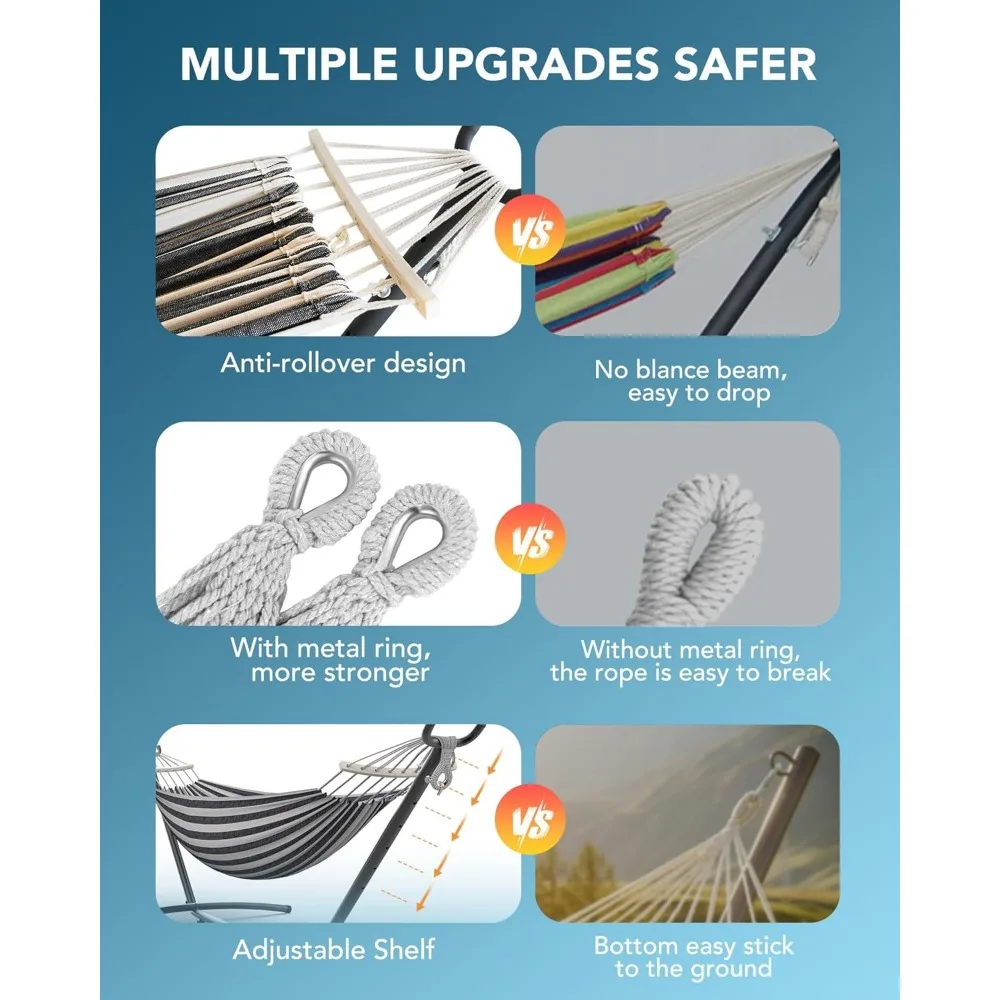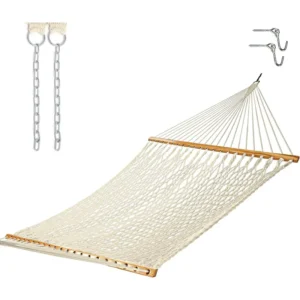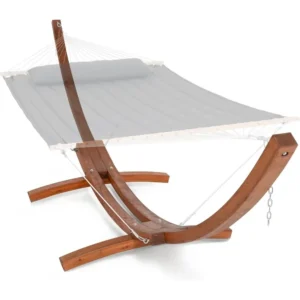When it comes to hammock relaxation, few considerations are as important as weight capacity. Understanding how much weight your hammock can safely support isn’t just about preventing a fall – it’s about ensuring your comfort, safety, and the longevity of your investment. Whether you’re a solo lounger or planning to share your hammock with a partner, knowing the weight limits is essential for a worry-free experience.
This comprehensive guide will walk you through everything you need to know about hammock weight support – from the basics of capacity ratings to the specific components that determine strength. We’ll explore typical weight limits for different hammock types, what happens when those limits are exceeded, and how to choose the perfect hammock for your needs.
Drawing on expert knowledge and industry standards, we’ve created this resource to help you make informed decisions about your hammock purchase and usage. Let’s dive into the world of hammock weight capacity guidelines to ensure your relaxation is both comfortable and secure.
I. Decoding Hammock Weight Capacity: Fundamentals and Importance
A hammock’s weight capacity refers to the maximum static load it can safely bear without compromising its structural integrity. This rating is carefully determined by manufacturers based on material strength, design features, and construction quality.
It’s crucial to understand the difference between static and dynamic loads:
– Static load refers to weight that remains still, like when you’re lying peacefully in your hammock
– Dynamic load involves movement or force, such as getting in and out, swinging, or sudden shifts in position
Respecting your hammock’s weight limit is non-negotiable for three key reasons:
- Safety: Exceeding weight limits can result in sudden failure, potentially causing injuries from falls, especially when hammocks are hung at height.
- Durability: Consistently overloading your hammock accelerates wear and tear on fabrics, stitching, and suspension components, significantly shortening its useful life.
- Comfort and Performance: A properly loaded hammock maintains its ideal shape and support, delivering the comfort experience you expect.
Most manufacturers build in a safety margin when rating their hammocks, but this shouldn’t be viewed as an invitation to exceed stated limits. Understanding how much weight can a hammock hold is the first step toward safe and enjoyable hammock use.
II. The Architecture of Support: Key Factors Determining Weight Capacity
A. Material Construction and Quality
The materials used in hammock construction play a pivotal role in determining weight capacity. Different fabrics offer varying levels of strength and durability:
- Nylon is lightweight yet strong, with parachute nylon being particularly resilient for its weight
- Polyester resists stretching and holds up well against UV damage, maintaining strength over time
- Cotton provides comfort but typically offers lower weight capacity than synthetic alternatives
The denier rating of fabric directly correlates to strength – higher numbers indicate thicker threads and generally stronger material. For instance, a 210D nylon hammock will typically support more weight than a 70D version of the same design.
The weave pattern also matters significantly. Tight, consistent weaves distribute weight more evenly and resist tearing better than loose or irregular patterns. High-quality hammocks feature reinforced stress points where the most tension occurs, significantly enhancing overall hammock material vs weight capacity performance.
B. Engineering and Design Elements
How a hammock is constructed directly impacts its weight-bearing capacity. Quality stitching is essential – look for:
- Double or triple stitching at critical seams
- Reinforced end loops that won’t unravel under pressure
- Consistent, tight stitching patterns throughout
Different hammock designs distribute weight in unique ways:
– Gathered-end hammocks create a natural center pocket that evenly distributes weight
– Spreader bar designs require stronger materials since weight is distributed along a rigid plane
– Bridge hammocks feature a more structured shape that can enhance weight distribution
Manufacturing quality control processes ensure consistent strength across production batches. Reputable manufacturers test their products under various conditions to verify weight capacity claims.
C. Suspension System Integrity
Even the strongest hammock fabric is only as reliable as its suspension system. Key components include:
- Straps: Wider straps (1-2 inches) distribute weight more evenly against trees or anchor points, reducing failure risk
- Carabiners and Hardware: Look for rated climbing-grade carabiners that specify their weight capacity, typically made from aluminum or steel
- Ropes and Cords: Thickness, material, and construction all impact load capacity
Remember the “weakest link” principle – your hammock system’s overall weight capacity is limited by its weakest component. A 500-pound capacity hammock attached with 300-pound rated hardware will only safely support 300 pounds.
The integration of hammocks spreader bars and standing frames creates different structural considerations that affect weight distribution and overall capacity.
III. Weight Capacity by Hammock Type: A Comprehensive Comparison
While this guide provides general information, always prioritize the specific weight ratings provided by your hammock’s manufacturer. These ratings are based on testing and should be your primary reference.
Here’s how weight capacities typically compare across different hammock categories:
Single Hammocks
Most single hammocks support between 250-400 pounds (113-181 kg). Ultralight backpacking models may have lower capacities around 250-300 pounds (113-136 kg) due to their focus on minimizing packed weight.
Double Hammocks
Designed for two people or extra space for one, double hammocks generally support 400-500 pounds (181-227 kg). Some ultralight double models may have capacities closer to 350 pounds (159 kg).
Heavy-Duty/XL Hammocks
These specialized hammocks feature reinforced materials and construction, supporting anywhere from 500-800+ pounds (227-363+ kg). They typically use thicker fabrics and enhanced stitching patterns.
Family/Multi-Person Models
The largest hammocks can accommodate 750-1000+ pounds (340-454+ kg), designed with multiple users in mind. These feature the strongest available materials and extensive reinforcement.
| Hammock Type | Typical Weight Capacity Range | Key Features |
|---|---|---|
| Single | 250-400 lbs (113-181 kg) | Standard size for one person |
| Double | 400-500 lbs (181-227 kg) | Wider design, room for two |
| Heavy-Duty/XL | 500-800+ lbs (227-363+ kg) | Reinforced construction |
| Family | 750-1000+ lbs (340-454+ kg) | Largest size, maximum reinforcement |
| Camping/Backpacking | 250-450 lbs (113-204 kg) | Lightweight but strong materials |
| Aerial Yoga | 200-600 lbs (91-272 kg) | Designed for dynamic movement |
For specialized activities like camping, manufacturers must balance between portability and strength. Camping hammocks typically support between 250-450 pounds (113-204 kg) while keeping packed weight and volume manageable.
Understanding the differences between single and double hammock weight limits helps ensure you select the appropriate option for your needs. For users requiring maximum support, our heavy-duty hammock sets offer exceptional capacity without compromising on comfort.
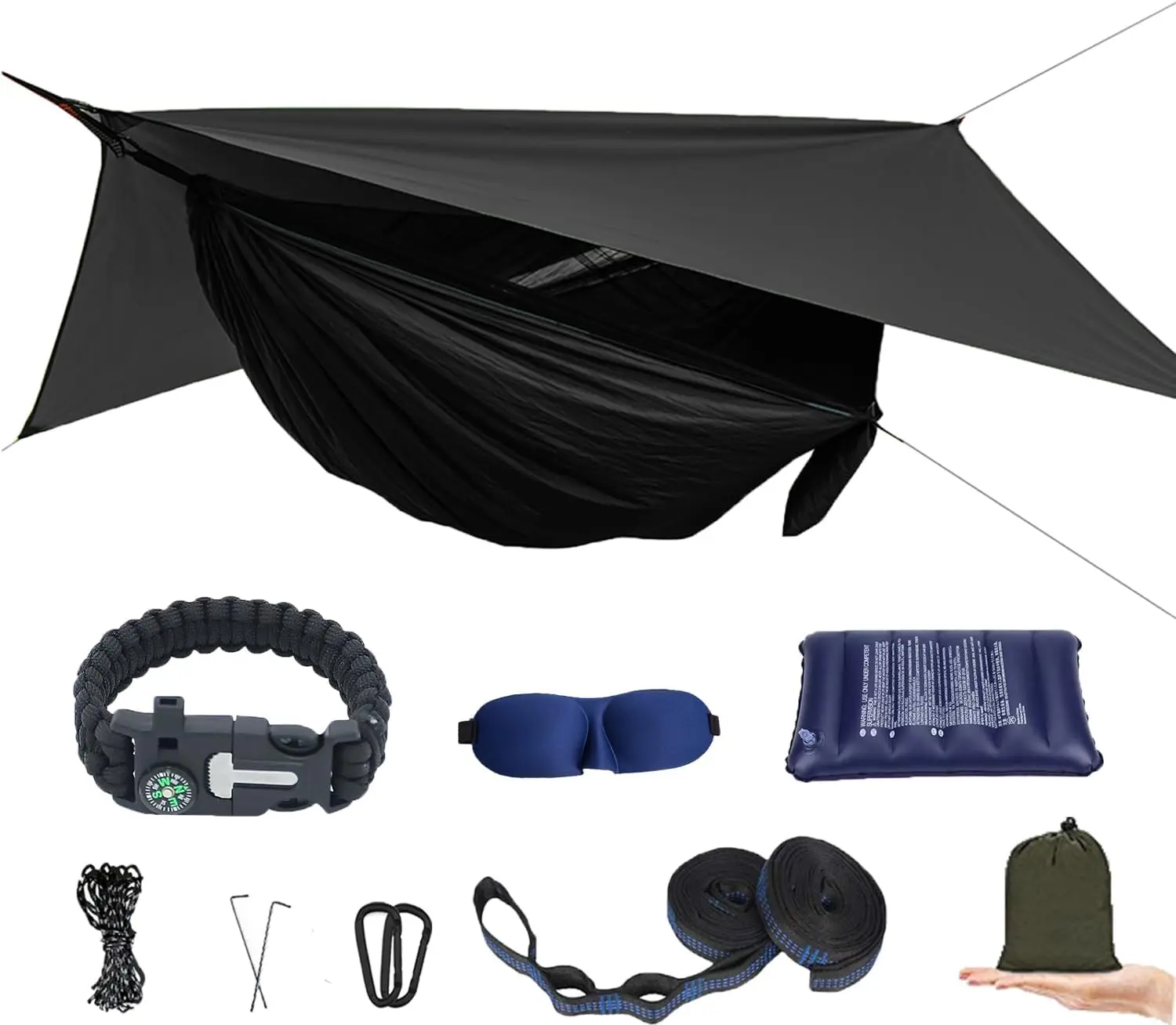
IV. Beyond the Limit: Understanding the Consequences of Overloading
Exceeding your hammock’s weight capacity can lead to serious consequences, both immediate and long-term.
Immediate Safety Hazards
When a hammock is overloaded, several dangerous scenarios can unfold:
– Catastrophic failure: Sudden tearing of fabric or breaking of suspension components
– Unexpected collapse: The entire hammock system giving way without warning
– Impact injuries: Falls resulting in bruises, sprains, broken bones, or worse depending on height and surrounding terrain
– Instability during use: Excessive swaying, flipping, or uneven weight distribution
Progressive Damage
Even if your overloaded hammock doesn’t fail immediately, consistent exceeding of weight limits causes cumulative damage:
– Fabric stretching and deformation that doesn’t return to its original shape
– Gradual weakening of stitching as threads begin to break individually
– Stress fractures in carabiners, hooks, or other hardware components
– Elongation and weakening of rope or strap fibers
Secondary Impacts
Beyond the obvious safety concerns, overloading causes other significant issues:
– Dramatically reduced comfort as the hammock sags inappropriately
– Voided warranty protection, as manufacturers won’t cover damage from improper use
– Shortened lifespan requiring more frequent replacement, which increases cost and environmental impact
For users with higher weight requirements, exploring hammocks for heavier individuals ensures you can find appropriate options rather than risking an underrated hammock.
V. The Complete Support System: Beyond the Hammock Itself
A hammock’s weight capacity depends not just on the fabric itself but on the entire support system working together.
Hammock Stands and Their Capacity
Hammock stands have their own independent weight ratings based on:
– Material strength: Steel stands typically offer higher capacities than aluminum or wood
– Design stability: Wider bases and lower centers of gravity allow for higher weight ratings
– Assembly quality: Properly tightened connections prevent wobbling and maintain structural integrity
Always check stand specifications separately from hammock ratings. A 500-pound capacity hammock used with a 300-pound capacity stand creates a system limited to 300 pounds.
Support Components and Hardware
Each link in your hammock system has its own weight limitation:
– Straps: Wider straps (at least 1 inch/2.5 cm) distribute weight better and protect trees
– Carabiners: Look for minimum ratings of 1,000+ pounds (454+ kg) breaking strength for adequate safety margin
– Rope and cord: Diameter, material, and construction technique all affect strength
Anchor Point Evaluation
Your hammock is only as secure as what it’s attached to:
– Trees: Select healthy trees with minimum diameter of 6 inches (15 cm)
– Wall mounts: Must be secured into studs or structural elements, never just drywall
– Posts: Need proper depth and concrete footings for stability
Understanding whether your ceiling can support a hammock involves careful assessment of structural elements, not just the visible mounting points. For reliable support without structural concerns, consider our A-frame stand hammock sets that provide complete support systems with matching capacity ratings.
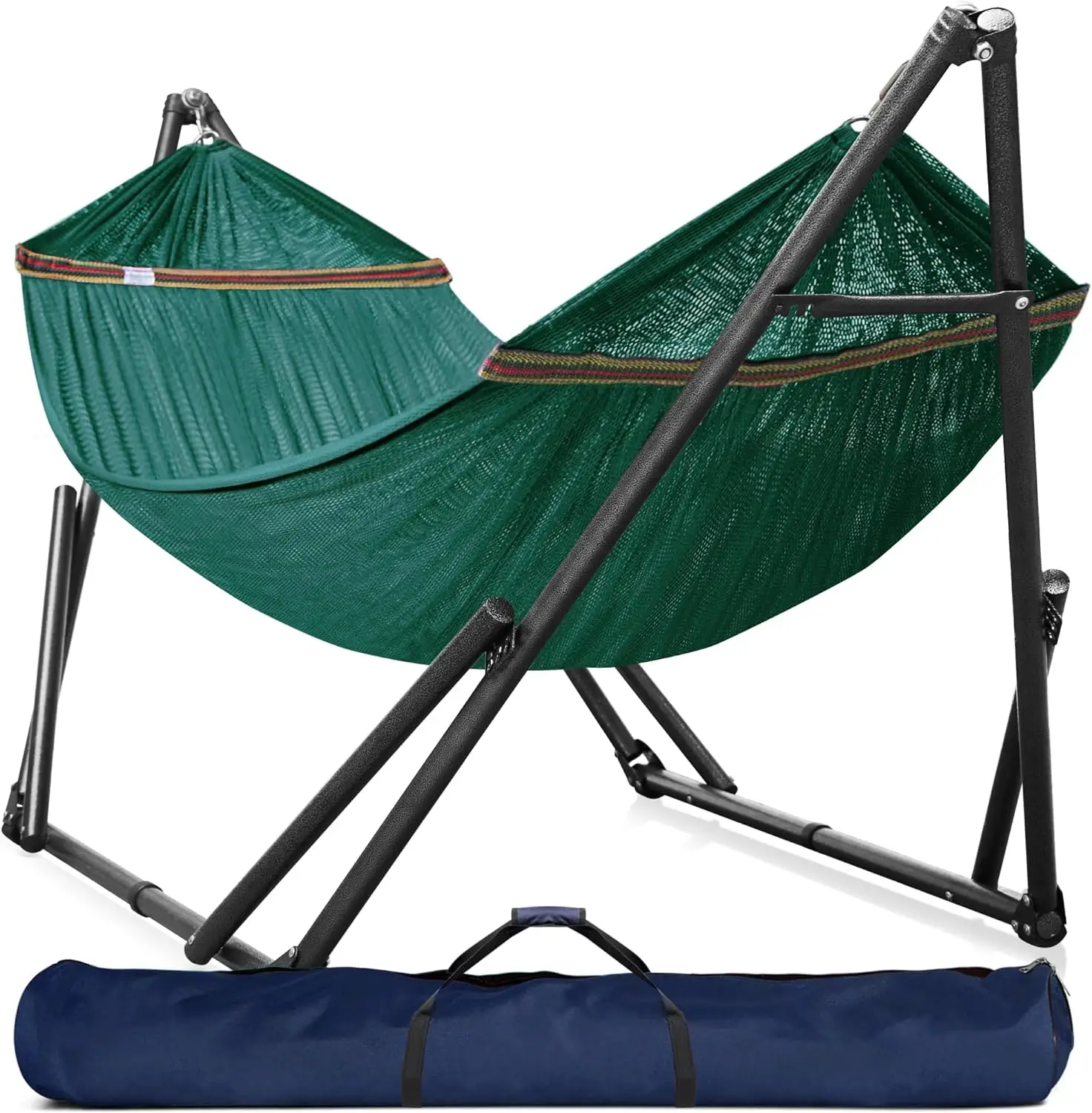
VI. Making the Right Choice: Selecting a Hammock with Adequate Support
Calculating Your Required Support
To determine the minimum weight capacity you need:
- Start with body weight: Your current weight in pounds or kilograms
- Add additional users: If sharing, add their weight
- Include gear weight: Add clothing, blankets, pillows (typically 10-20 pounds/4.5-9 kg)
- Activity factor: For active usage (swinging, getting in/out frequently), add 10-15% to account for dynamic forces
For example: A 185-pound (84 kg) person with 15 pounds (6.8 kg) of gear would need a minimum capacity of 200 pounds (91 kg).
The Importance of Safety Margins
Always select a hammock rated significantly higher than your calculated minimum:
– Aim for at least 50-100 pounds (23-45 kg) over your calculated need
– Or choose a capacity 20-30% higher than your total weight requirement
– This margin accommodates unexpected situations, guests, and provides peace of mind
Hammocks closer to their maximum capacity often feel less comfortable and wear out faster than those used well below their limits.
Finding and Interpreting Manufacturer Specifications
When evaluating product information:
– Look for explicit weight capacity statements on packaging or specifications
– Be wary of vague terms like “heavy-duty” without specific numbers
– Understand that “single” or “double” designations don’t guarantee specific weight capacities
– Consider manufacturer reputation and testing standards
If you’re planning to share your hammock regularly, our double two-person hammock sets are specifically designed with appropriate capacity ratings for two adults.
A-Frame Stand Hammock Sets, Swinging Hammock Chair Sets
$154.62 Select options This product has multiple variants. The options may be chosen on the product pageCamping Hammock Sets with Bug Net, Ultralight Camping Hammock Sets
$139.72 Select options This product has multiple variants. The options may be chosen on the product pageClassic Wooden Stand Hammock Sets, Heavy Duty Hammock Sets
$1,061.68 Select options This product has multiple variants. The options may be chosen on the product pageHammock Sets with Canopy, Heavy Duty Hammock Sets
$286.31 Select options This product has multiple variants. The options may be chosen on the product pageDouble / Two Person Hammock Sets, Rope Hammock Sets
Double Traditional Cotton Rope Hammock with Extension Chains – 450 lbs Capacity for Backyard & Patio$292.98 Select options This product has multiple variants. The options may be chosen on the product pageHeavy Duty Hammock Sets, Wooden Arc Stand Hammock Sets
$878.66 Select options This product has multiple variants. The options may be chosen on the product page
VII. Preserving Strength and Safety: Maintenance Best Practices
Regular Inspection Routine
Develop a habit of checking your hammock before each use:
- Fabric integrity: Look for tears, thinning material, or unusual stretching
- Seam examination: Check for loose threads, separation, or fraying
- Suspension components: Inspect straps for fraying, hardware for bending or corrosion
- End loops and attachment points: Examine areas where fabric meets suspension for signs of wear
More thorough inspections should be performed seasonally, especially after storage or before heavy use periods.
Proper Cleaning Methods
Maintaining your hammock’s strength requires appropriate cleaning:
- Follow material-specific guidelines (nylon, cotton, polyester require different approaches)
- Avoid harsh chemicals that can degrade fibers (bleach, strong detergents)
- Hand wash when possible, using gentle motions rather than wringing
- Air dry completely before storage to prevent mildew that weakens fabric
Storage Best Practices
How you store your hammock directly affects its strength retention:
- Keep out of direct sunlight when not in use to prevent UV degradation
- Store in a cool, dry place to prevent mold and mildew
- Avoid sharp objects that could puncture or tear fabric
- Store loosely rather than tightly compressed for extended periods
Understanding proper hammock installation requirements and safety guidelines ensures your entire system maintains its integrity and weight capacity over time.
VIII. Expert Answers: Frequently Asked Questions About Hammock Weight Support
Can double hammocks safely support two adults?
While double hammocks are wider than singles, don’t assume they automatically support twice the weight. Always check the specific weight rating rather than relying on the “double” designation. Two adults create different weight distribution than a single user, with more stress on the center. For safe dual occupancy:
- Confirm the specific weight capacity exceeds the combined weight of both users plus gear
- Position yourselves to distribute weight evenly
- Consider how you’ll enter and exit to avoid dynamic stress
Do manufacturer weight ratings account for movement?
Most manufacturer ratings specify static load capacity (weight at rest). Movement creates dynamic forces that can temporarily exceed static ratings. Quality hammocks include some safety margin, but excessive movement (swinging, bouncing, sudden entries) can create forces several times greater than your actual weight. Active users should:
- Choose hammocks rated significantly higher than their weight
- Enter and exit carefully to minimize sudden force
- Avoid aggressive swinging or bouncing
How reliable are manufacturer weight specifications?
Reliability varies between manufacturers. Established brands typically conduct standardized testing and provide conservative ratings with built-in safety margins. Lesser-known manufacturers might provide optimistic estimates or lack rigorous testing protocols. Signs of reliable ratings include:
- Specific numbers rather than vague terms
- Testing methodology information
- Consistent ratings across similar products
- Separate ratings for different components (hammock, stand, suspension)
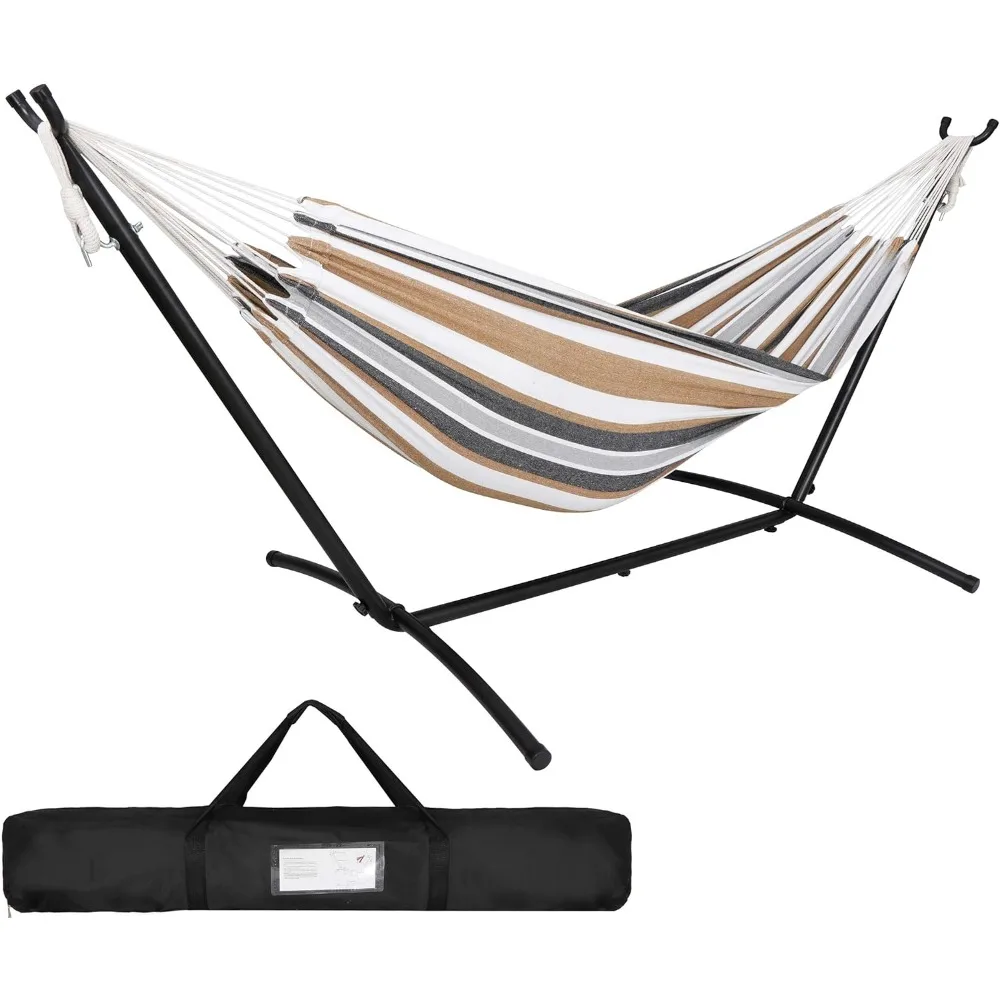
Which component most influences weight capacity?
While every component matters, the weakest link determines your system’s capacity. Common failure points include:
- Fabric tears at stress points where the hammock body meets suspension
- Suspension straps fraying or snapping
- Hardware bending or breaking
- Anchor point failure (wall mounts pulling free, stands tipping)
A properly designed system distributes weight evenly across all components, with each rated appropriately for the intended use.
Can I increase my hammock’s weight capacity?
While you can upgrade certain components, the hammock body itself has inherent limitations based on material and construction. Possible improvements include:
- Installing wider, stronger suspension straps
- Upgrading to higher-rated carabiners or hardware
- Adding reinforcement to attachment points
However, these modifications can’t overcome fundamental fabric strength limitations. For safety, upgrading to a properly rated hammock is preferable to attempting DIY reinforcement.
What’s the difference between weight capacity and breaking strength?
Weight capacity is the manufacturer’s recommended maximum load for safe, normal use. Breaking strength is the point at which catastrophic failure occurs during testing – typically several times higher than the rated capacity.
The difference represents your safety margin. Never load a hammock close to its breaking strength, as this doesn’t account for material fatigue, dynamic forces, or environmental factors. Proper understanding of hammock load capacity includes recognizing this crucial distinction.
For specific activities like camping where weight distribution differs from casual use, explore our camping hammocks and stands designed with appropriate support for outdoor adventures.
IX. Safety and Comfort: The Ultimate Balance
Understanding and respecting weight capacity isn’t just about preventing accidents – it’s about creating the optimal hammock experience. A properly loaded hammock maintains its ideal shape, providing the ergonomic support and gentle cradling sensation that makes hammock relaxation so appealing.
When selecting your next hammock, remember that going beyond minimum requirements often results in better performance and longer product life. Consider weight capacity as an investment in both safety and enjoyment.
By choosing appropriate capacity, regularly inspecting your equipment, and understanding the interconnected nature of your hammock system, you’ll ensure countless hours of comfortable, worry-free relaxation. Whether you’re looking for traditional designs like our rope hammock sets or contemporary options, prioritizing proper weight support creates the foundation for the perfect hammock experience.

